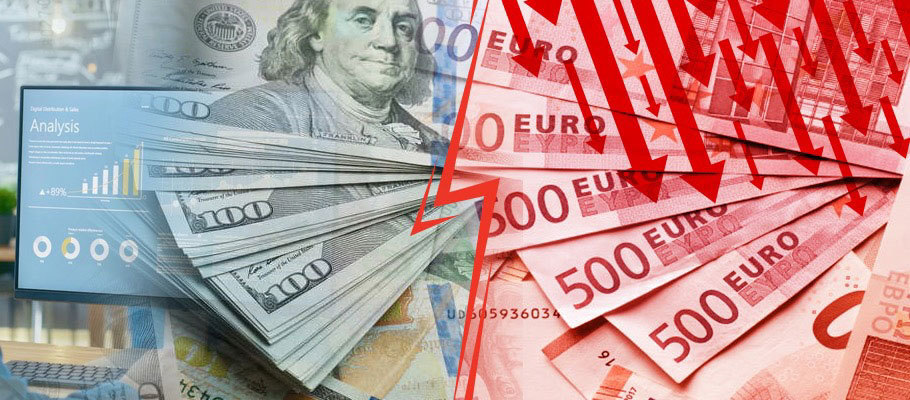
Published: February 22nd, 2023
EUR will remain on the back foot against the mighty US Dollar according to forex analysts at MUFG. The bank’s FX strategy unit wrote in its weekly market briefing that USD’s comeback hasn’t been hindered by risk-off sentiment, or trader concerns about the imminent release of minutes by the US Fed’s open markets committee.
With investors also shrugging off PCE deflator data due later this week, MUFG says we may be witnessing the near-term return of Dollar dominance.
‘The upward adjustment to a higher terminal rate and cooling rate cut expectations for later in 2023 have spurred new life into the strong USD trade we saw at the end of 2022,’ says MUFG’s briefing.
Adding wind to USD’s sails is a lifting of investor expectations about the timing of the Federal Reserve's peak interest rate hiking cycle.
In January, consensus had the last rate rise set for March, but an additional two hikes have since been added to the table.
The likelihood of a rate cut in the latter part of 2023 has receded, giving the Dollar support after an underwhelming end to 2022 and beginning to 2023.
EURUSD rushed toward 1.10 in January but had fallen back by early February as new US economic data flummoxed analysts, who sent mixed signals into the market.
A surprising mix of strong wage data, labour market dynamics, inflation figures and retail sales suggested the American economy was robust enough to achieve the Fed’s above-target inflation levels. EURUSD started to retrace previous gains as a result.
‘Stronger American growth data blended with firmer inflation at the beginning of 2023 has added optimism to markets. Forex traders are now pricing-in a more hawkish outlook for Fed policy’.
Going into March last year, spiking oil prices were pushing the Euro toward multi-year lows as forex traders bet that the European Central Bank would delay plans to raise interest rates later in the year.
Prices for Brent Crude surged above USD 130 per barrel in March 2022, the highest level for almost 13 years. Wholesale gas prices meanwhile more than doubled from the previous month on fears that the US and EU were considering an unequivocal ban on Russian oil.
The US did move forward with plans to ban purchases of Russian oil and gas, with other G7 countries following suit. European natural gas prices responded by hitting an all-time high.
In a note to investors, the FX Strategy unit at Crédit Agricole wrote that news of major Western importers considering coordinated sanctions against Russian energy exports sent oil and other commodity prices soaring, especially in Asia.
‘Conjecture around ramped up sanctions in the energy sector has started with a bang. Stocks have tumbled and crude prices are soaring on Asian markets as traders' price-in the impact of a US and EU ban on Russian crude supplies’.
In response to the supply shock, Crédit Agricole said a ‘binary move’ in currency markets was underway, one that favoured the fiats of energy exporting countries. Net energy importing countries, in contrast, would see their currencies take a hit.
In a weekly currency research briefing note, Barclays said at the time that the Ukraine conflict had delivered a negative EUR shock.
‘In the near term, the Euro has scope to trade lower given the potential stagflation effect on the Eurozone. Looking further ahead, the war could compel more structural integration by member states that provides EUR with support.’
The Pound to Euro exchange rate reached 1.2177 on Tuesday 8th March, the highest level since June 2016. The Euro to Dollar rate dipped to 1.0857, the lowest level since April 2020.
Economists expected surging oil and gas prices to drag the Eurozone economy downward due to its reliance on Russian gas and deep integration with Russia's energy industry.
In an interview with Bloomberg, an analyst from BMO Capital Markets European FX Strategy unit said that a negative relationship would strengthen between the price of crude oil and EUR/USD.
‘We believe forex traders will devote significant time this week to watching how these variables play out. The risk of an all-out EU ban on Russian oil imports will be one of the most important factors hanging over EUR/USD.’
There were also concerns in the market that a dip in Eurozone economic growth could see the ECB cool enthusiasm for its planned post-COVID normalisation of monetary policy. A change in course might have limited Eurozone bond yields and pulled the Euro down further.
'Rising prices for commodities across the board could force central banks to slam the brakes on interest rate rises. That’s impacting EUR sentiment,’ said BMO.
As the conflict raged on, Ukraine applied heavy diplomatic pressure on the EU as it sought to ban imports of Russian oil, with the country’s foreign minister telling major news outlets this week that it comes ‘steeped in Ukrainian blood.’
Antony Blinken, America’s Secretary of State, told journalists that the US was in ‘active discussions with European partners’ about stopping purchases of Russian oil while also sustaining a reliable global oil supply.
After the White House announced its Russia oil ban, forex traders began calculating how supplies of oil will be maintained in the Eurozone, and what the broader impact on crude prices might be.
While the UK indicated that it would support a cap on how much Russian oil and gas G7 countries can purchase, both Westminster and Brussels have made lots of noise about keeping Russian oil out of their respective markets, while avoiding talk of an outright ban.
EU Commission President Ursula von der Leyen said that new sanctions on Russia would be coming, but an outright European ban on Russian oil probably isn't in the cards.
‘Our objective has to say focused on isolating Vladimir Putin and make it harder to finance the Ukraine war.’